ISSN ONLINE(2319-8753)PRINT(2347-6710)
ISSN ONLINE(2319-8753)PRINT(2347-6710)
D.D. Pawar 1, B. Sridhar Babu 2
|
| Related article at Pubmed, Scholar Google |
Visit for more related articles at International Journal of Innovative Research in Science, Engineering and Technology
A vortex tube is a simple energy separating device which splits a compressed air stream into a cold and hot stream without any external energy supply or chemical reactions. This paper presents an overview of recent research on Ranque-Hilsch Vortex Tube (RHVT) with divergent tube and snail entry, increase in nozzle number and supply pressure leads to the rise of swirl / vortex intensity & thus maximum energy separation in the tube. The paper develops three dimensional flow domain using Computational Fluid Dynamics (CFD) and this CFD and experimental studies are conducted towards the optimization of RHVT. The optimum cold end diameter (dc), number of snail entry and optimum parameters for obtaining the maximum hot gas temperature and minimum cold gas temperature are obtained through CFD analysis and validated through experiments.
KEYWORDS |
| CFD analysis, Energy separation mechanism, Experimental validation, Ranque –Hilsch vortex tube. |
I. INTRODUCTION |
| The vortex tube is a simple mechanical device which is also known as the Ranque–Hilsch vortex tube (RHVT), operating as a refrigerating machine without any moving part e.g. rotating shafts or piston cylinders. It consists of a principal tube, which a high-pressure gas stream enters tangentially, and splits in two low pressure hot and cold temperature streams. Cold gas stream leaves the tube through a central orifice near the entrance nozzle, while hot gas stream flows toward regulating valve and leaves the tube. Ranque-Hilsch vortex tube dates back to the 1930s where French physicist George Ranque invented an early prototype. Around 1945 when the German army occupied most of France, Rudolf Hilsch, a German physicist improved RanqueâÂÂs design to create a better version of the tube. The tube was named after the inventors, but most often is attributed to Hilsch, who made the more notable version. Device itself is illustrated in Fig. 1. As you can see it is a fairly simple piece of equipment with only few parts. |
| Ranque–Hilsch vortex tube having, relatively simple geometry, no moving mechanical parts and no need for absolute sealing element, was invented by Ranque in 1933, demonstrating the effect of temperature separation of gases. Later, Hilsch described this effect in detail in 1947. Intensive experimental and analytical studies of Ranque–Hilsch effect began since then and continue even today. |
| The objective of the current research is to find out the optimum value of cold end temperature and mass of the cold air with enhancing the COP and cooling effect by designing the vortex tube with best possible design parameters with the help of CFD and experimental techniques. This work uses many previous experimental results to provide comparisons with theoretical approximations and thus validation of suggested method is described. |
| First part of research program focuses on the experimentation of the vortex tube using CFD by preparing the three dimensional flow domains to determine the optimum value of cold end temperature. The second part includes the design and manufacturing of divergent vortex tube. The experimental test set up is performed in laboratory and experiment was carried out to determine the optimum value of cold end temperature, cooling effect. The third part of this work consists, comparison of the results obtained from CFD analysis and experimental studies. |
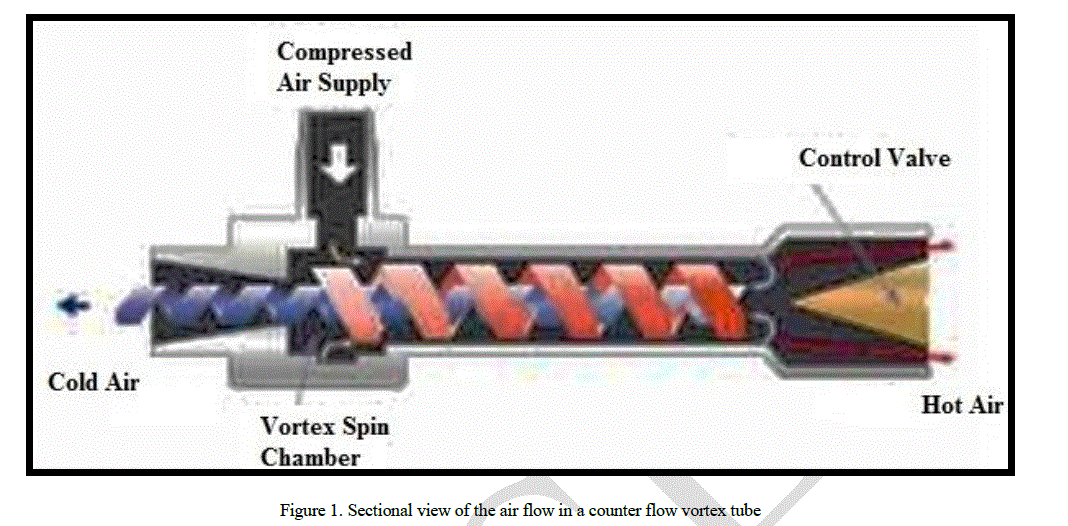 |
II. LITERATURE SURVEY |
| Upendra Behera, P.J. Paul [1] presented the result of CFD and experimental analysis of vortex tube. The CFD and experimental studies have shown that for 12 mm diameter vortex tube, the cold end diameter of 7 mm is ideal for producing maximum hot gas temperature while cold end diameter of 6 mm is optimum for reaching the minimum cold gas temperature. An experimental investigation was made by Kirmaci Volkan [2] to determine the effects of the orifice nozzle number and the inlet pressure on the heating and cooling performance of the counter flow Ranque–Hilsch vortex tube when air and oxygen used as a fluid. Nimbalkar S., Muller M. R. [3] presented the results of a series of experiments focusing on various geometries of the „„cold end side” for different inlet pressures and cold fractions. The experimental results indicate that there is an optimum diameter of cold end orifice for achieving maximum energy separation. Bramo, A. R., Pourmahmoud N. [4] performed computational fluid dynamics analysis in an attempt to investigate the effect of length to diameter ratio on the fluid flow characteristics and energy separation phenomenon inside the Ranque-Hilsch vortex tube. In this numerical study, performance of Ranque-Hilsch vortex tubes (RHVT), with length to diameter ratios (L/D) of 8, 9.3, 10.5, 20.2, 30.7 and 35 with six straight nozzles was investigated. It was found that the best performance was obtained when the ratio of vortex tube length to the diameter was 9.3. Chang K., Li Qing, Zhou G., Li Qiang, [5] performed Experimentation with hot divergent tube and found that the Energy separation performance of vortex tube can be improved by using a divergent hot tube. |
III. DESIGN OF VORTEX TUBE |
A. Design constraints: |
| Geometrical parameters for the design of vortex tube plays very important role on the performance of the vortex tube. Thus many researchers have described the optimum value of the geometrical parameters for best possible performance of the vortex tube. Thus following restrictions are followed: |
| 1) For obtaining the maximum temperature difference at cold end, the ratio L/D should be maintained in the range of 20 ≤ L/D ≤ 55.5. |
| 2) Optimum value of dc for maximum temperature difference at cold end and maximum efficiency has been given as dc ê 0.5mm. or should be in the range of 0.4 < dc/D < 0.7 |
| 3) The cold mass fraction is the most important parameter indicating the vortex tube performance and the temperature / energy separation inside the vortex tube. Cold mass fraction is defined as the ratio of cold air mass flow rate to inlet air mass flow rate. This is given by, yc = mc /mi. it gives better result of temperature drop in the range of yc= 0.3 to 0.4. |
| 4) Geometry of vortex tube for maximum temperature drop ,following relationship between tube cross section area, nozzle cross section area and cross section area of cold end orifice is given as, An/At = 0.084 to 0.11 and Ac/At = 0.08 to .145. |
| 5) Decreasing conical vale angle have positive effect on performance of vortex tube but not so much difference is observed in the temperature reduction. Therefore it is better to use conical valve with smaller angle in order to improve the performance of vortex tube. |
| 6) The schematic diagram of the vortex tube is shown in Fig. 2 and consists of the following parts |
B. Vortex tube terminology: |
| The schematic diagram of the vortex tube is shown in Fig. 2 and consists of the following parts: |
| a) Main Divergent Tube, |
| b) Vortex chamber, |
| c) Cold end orifice, |
| d) Control Valve (cone type), |
| e) Hot End |
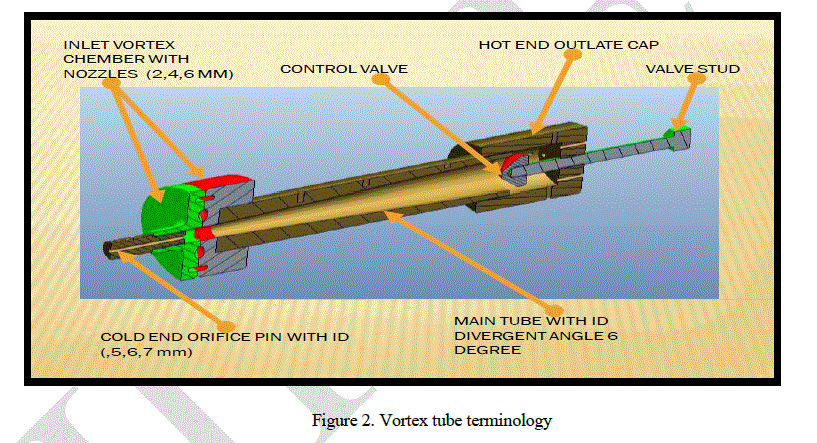 |
| Chamber is a portion of nozzle in the same plane of nozzle and facilitates the tangential entry of high velocity air stream into hot side. Generally, the chambers are not of circular form, but they are gradually converted into spiral form. Hot side is cylindrical in cross section and is of different lengths, as per designs Prof. Parulekar has proposed 3D as the effective length of hot side for the efficient operation of the vortex tube. Control valve obstructs the flow of air through hot side and it also controls the quantity of hot air through vortex tube. |
IV. COMPUTATIONAL FLUID DYNAMICS ANALYSIS |
A. Governing Equations in Computational Fluid Dynamics: |
| All of Computational Fluid Dynamics, in one form or other is based on fundamental governing equations of fluid dynamics, |
| ï· Continuity Equation, |
| ï· Momentum Equation |
| ï· Energy Equation. |
| These equations speak physics of fluid flow. They are the mathematical statements of three fundamental physical principles upon which all fluid dynamics is based. Continuity Equation is based on the principle of conservation of mass. |
| Net mass flow out of control volume = Time rate of decrease of mass inside control Volume |
| Mass Conservation Equation: |
 |
B. Boundary conditions: |
| The boundary condition used in this work is Static pressure with temperature at inlet of vortex tube and static pressure at cold & hot end. The domain surface is used as wall with no-slip condition. All details are given in Table I. |
C. Grid Generation: |
| The ANSYS ICEM is used for discrimination of domain. The mesh used for flow domain is hexahedral fine mesh for domain. A high quality hexahedral unstructured mesh is created as shown in Fig. 3. |
D. Mesh parameter: |
| No. of Hexa Elements: 1200380, Minimum angle: 18°, Aspect ratio: 1.9, Quality: 0.17. |
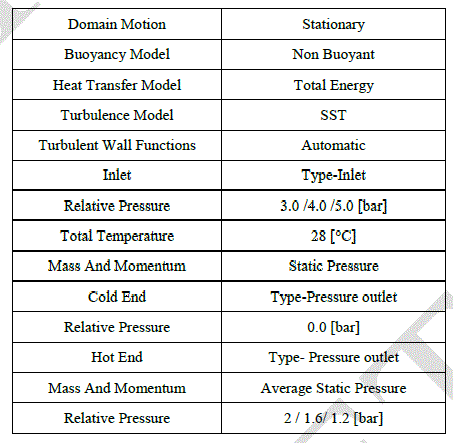 |
 |
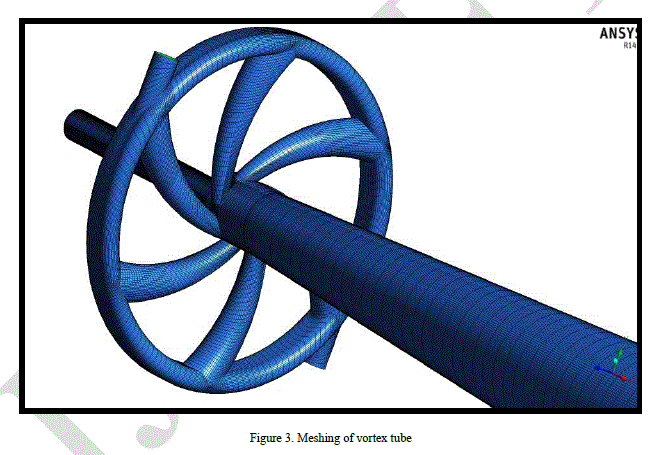 |
E. CFD results of 5, 6 and 7 mm orifice diameter with 5 bar inlet pressure: |
| Fig. 4 shows the total temperature contour at centre plane of the vortex tube for 7 mm orifice. |
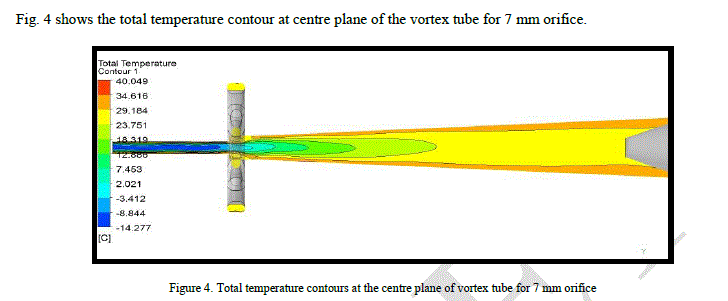 |
| Total temperature contours plot shows total temperature in the vortex tube towards the hot & cold end. From Fig. 4, 5 and 6, it can be observed, due to high swirling flow the temperature get increased towards the outer side of the diameter means temperature is lower at the centre of the tube and get increased towards the outside of the tube. Also temperature towards cold end goes on decreasing & toward hot end gets increased. |
V. TEST SETUP |
| The aim of this project is to obtain maximum temperature drop. So, there was need of suitable temperature sensing device with some means of measure and indicate that temperature. Here in our set up we have used three RTD sensors and a digital temperature indicator. Also we need to measure the flow of air through the system. ThatâÂÂs why we have used Rotameter as flow measuring device. The FRL (Filter, Regulator and Lubricator) unit is also required as Filter ensures clean air free from dust, moisture and abrasive particles. Regulator is used to control the pressure also pressure indicator is provided to indicate the pressure. Lubricator is used to lubricate the air. The set up for experimentation is shown in Fig. 7. |
| The list of components used is as follows: |
| 1. Air Compressor, |
| 2. F.R.L. Unit, |
| 3. Vortex Tube, |
| 4. Rotameter, |
| 5. Temperature Sensors and Indicator, |
| 6. Pneumatic pipes with connectors, |
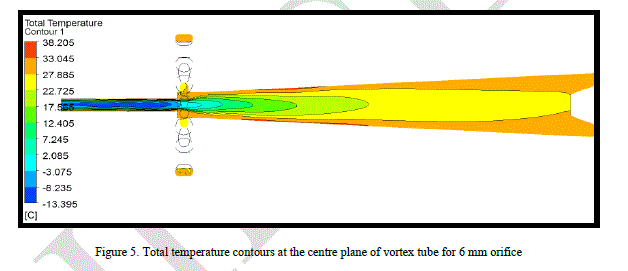 |
VI. ANALYSIS RESULTS AND DISCUSSION |
A. Introduction: |
| In this chapter, the results of CFD analysis and experimental study are summarized and relative comparison has been presented. In this work design, manufacturing, analysis and CFD model of vortex tube for cold air temperature and cold air mass flow rate has been carried out. In this present work, CFD models as well as experimental models for calculating cold air temperature and cold air mass flow rate for different pressures and different cold end orifices have been developed. The experimental results presented herein are verified and compared with CFD results. |
B. Results and Discussion: |
| Comparison between the experimental results and CFD analysis results for the average cold air temperature and cold air mass flow rate is as shown in the Table II and III. |
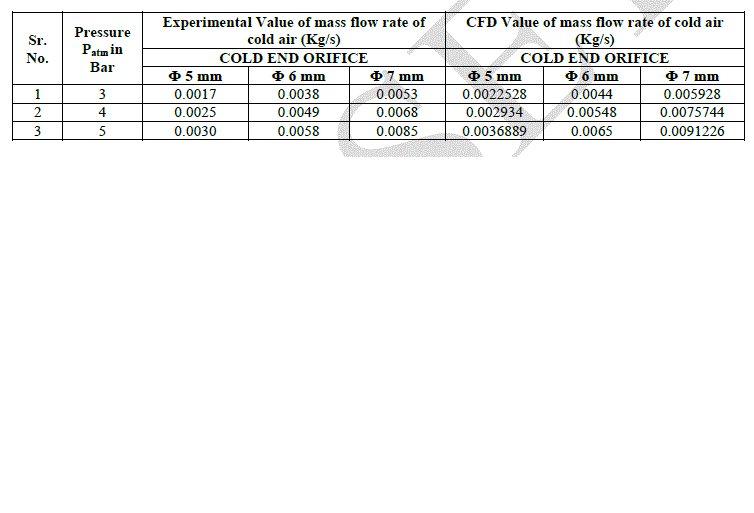 |
C. Discussion: |
| From above result it is found that there is very less difference in the values of cold air temperature and cold mass flow rate obtained from the experimental techniques and CFD analysis method. It is also shown graphically in Fig. 8, 9, 10 and 11 as follows: |
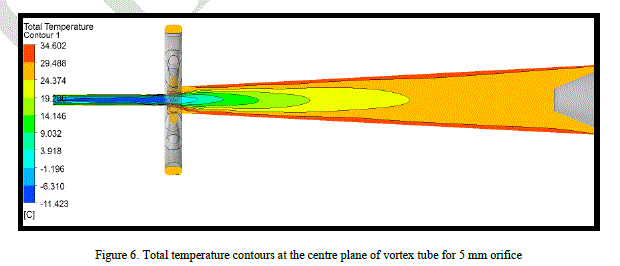 |
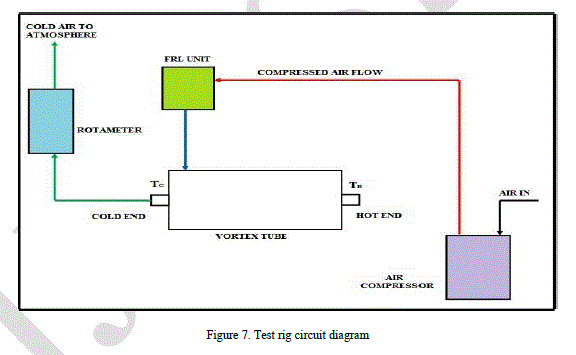 |
VII. CONCLUSION |
| The experimental and CFD work conducted shows the following results to determine the cold air temperature and the cold air mass flow rate of the vortex tube: |
| 1. The CFD analysis is an extremely useful tool in the design and analysis of Vortex tube. |
| 2. The CFD enables the complete view of the cold air temperature of the vortex tube. |
| 3. The CFD analysis shows the temperature at the core region of the cold orifice as below 0° C with different combinations of inlet air pressure, inlet nozzles and cold end orifice. |
| 4. It is found that, increasing inlet nozzle number, increasing inlet pressure and decreasing the cold air orifice diameter up to dc = 5 mm, decreases the cold air temperature at cold end of the vortex tube. |
| In case of cold mass flow rate, its value increases with increasing the internal diameter of cold end orifice, but have higher temperature of cold air than that of 5 mm cold end orifice. |
References |
|